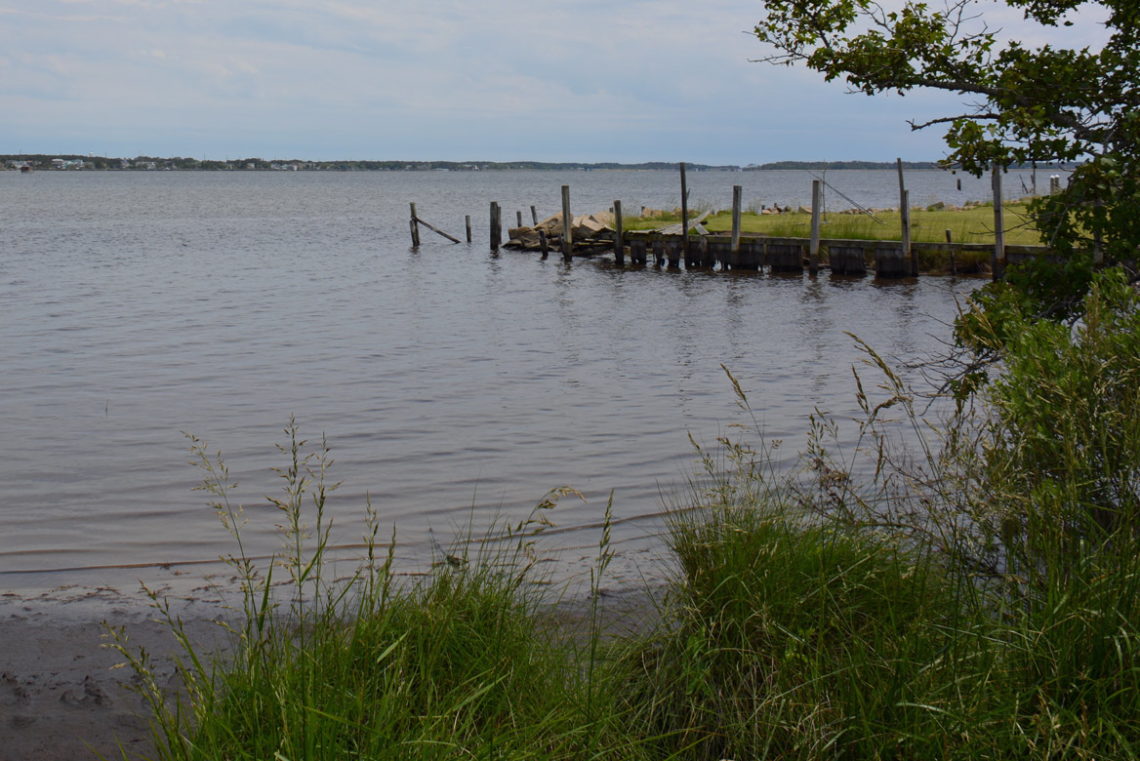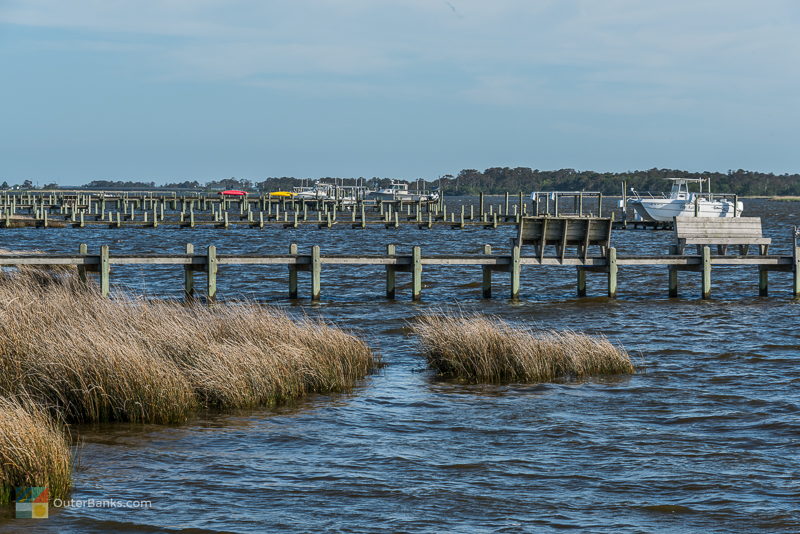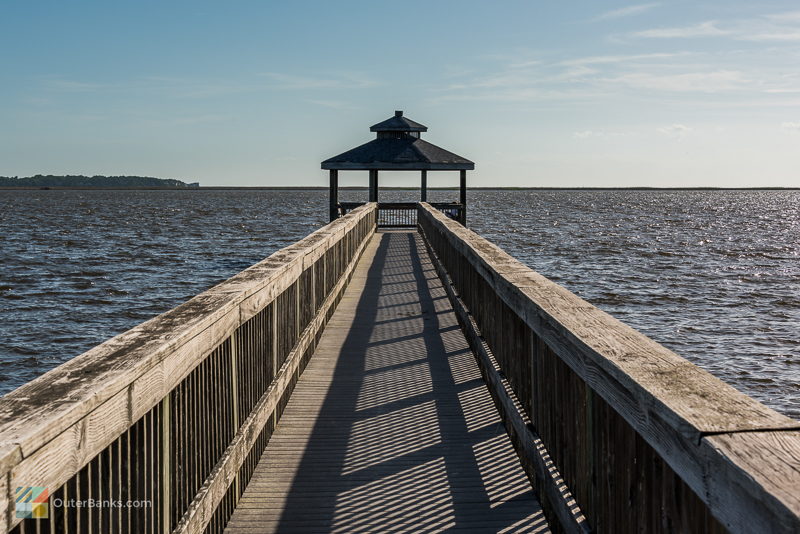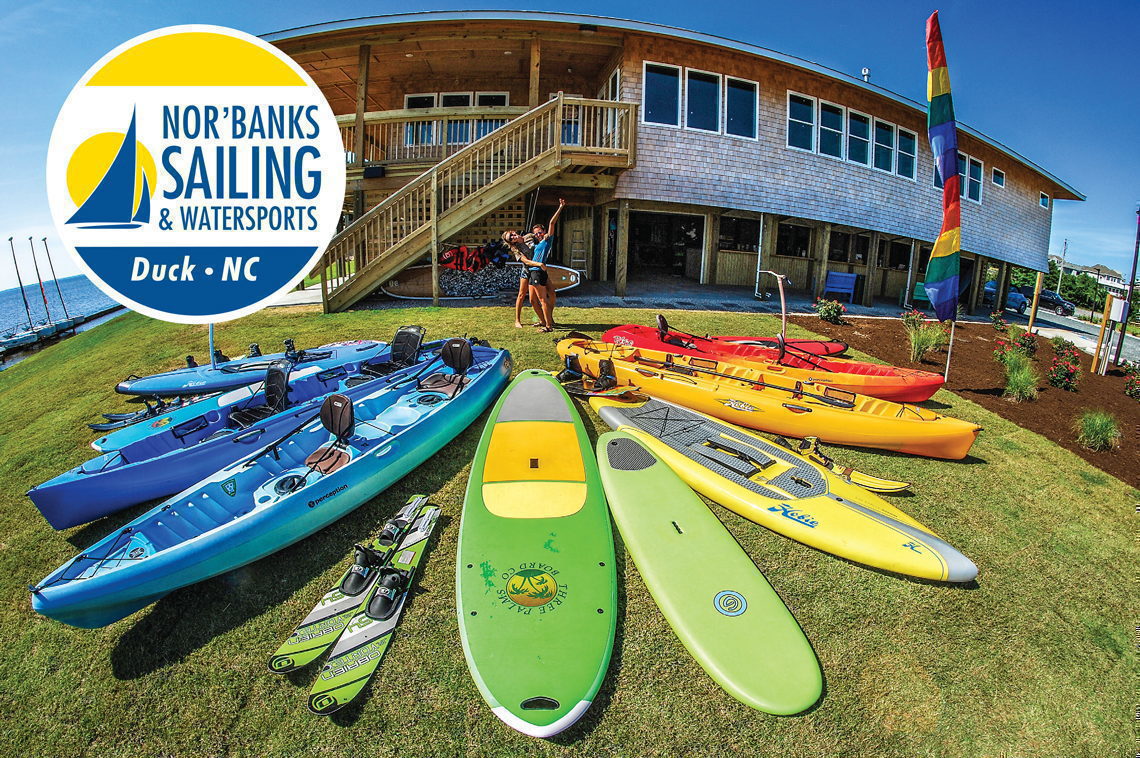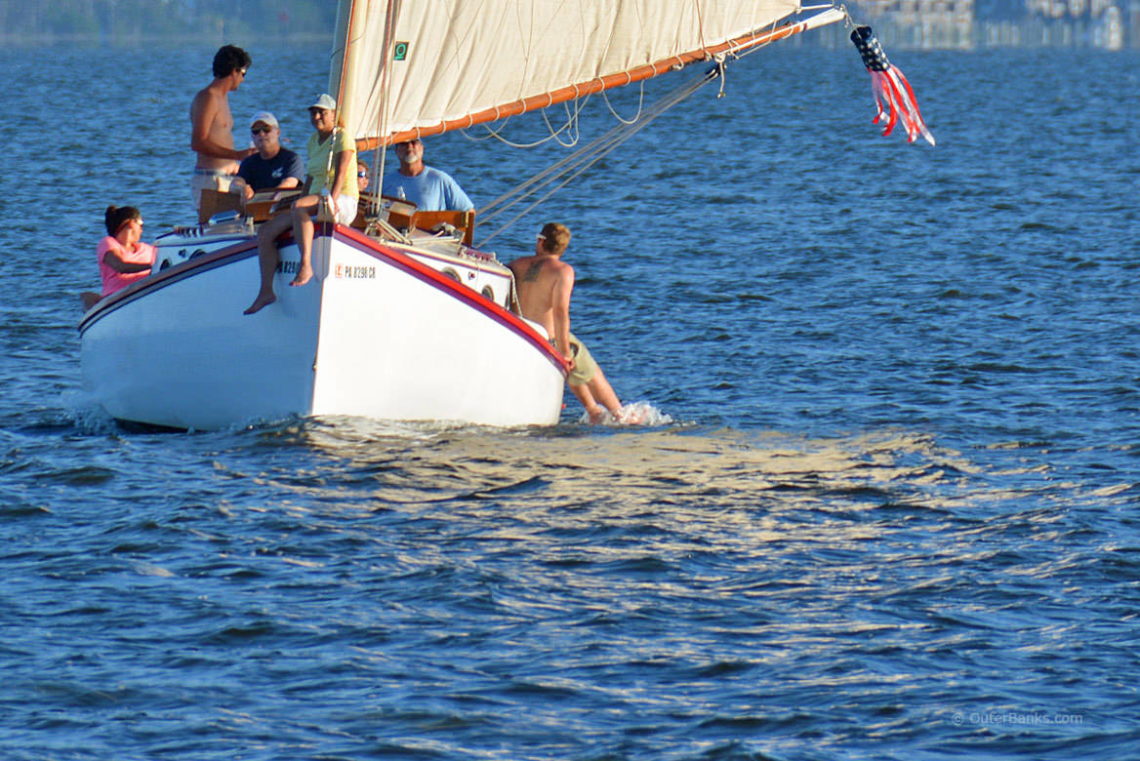Central and Northern Outer Banks visitors can combine their love of water and nature with a visit to the scenically serene Kitty Hawk Bay. Encompassing a large portion of the central beaches soundside waterfront, the bay is a protected refuge for countless wildlife, a playground for kayakers, boaters and fishermen, and a paradise for anyone who loves an unobstructed sunset over miles of water.
Plan a kayaking tour during your vacation for natural expedition you won't soon forget, or bring a boat along and spend a sunny day getting lost in the maze of marshy islands that lie just offshore. With undiscovered terrain around every watery corner, and some of the best bird watching on the beach, this expanse of soundside water is definitely worth a wild exploration.
The Geography of Kitty Hawk Bay
Kitty Hawk Bay is a surprisingly far reaching body of water. Cutting into the soundside of the central Outer Banks region, the bay borders Colington Harbor, Kill Devil Hills and the southern regions of Kitty Hawk in addition to the miles of open water of the Albemarle Sound.
The bay is effectively a semi-circle which is protected from the expanse of the sound by the northern borders of Kitty Hawk which jet out into the water, and the southern island of Colington which also sticks out and curves north, providing the lagoon-like shape of Kitty Hawk Bay. Because it is somewhat cut-off from the rest of the Albemarle Sound, the bay resembles a shallow brackish and freshwater lake, with relatively few waves, and a cluster of low-lying, naturally formed marshes and islands clustered in the middle of the watery enclosure.
Because of its centralized location, Kitty Hawk Bay can be easily visited by vacationers staying in a number of regions, including Southern Shores, Kitty Hawk, Kill Devil Hills and Nags Head, and has a number of residential and vacation rental communities stationed along its shores.
The bay and the islands within the bay are actually a part of the Kitty Hawk Woods Natural Reserve, and as such, all the rules and regulations that apply to this natural and protected portion of the Outer Banks apply within the borders of the bay as well. Littering, disturbing, or removing the plants and wildlife are all prohibited, however the bay is open year-round for explorers, and hunting and fishing are both permissible with the proper permits.
While jet skiers and boaters will most likely want to explore the wide open plains of water that lead out to the Albemarle Sound, kayakers will want to explore the islands and the intricate waterfront canals that wind through the bay's borders. On the northern end, a series of navigable canals, in between Bob Perry and Thick Ridge roads, lead kayakers all the way through the heart of Kitty Hawk Woods, while the marshy lowlands in the center of the bay create an intricate maze of canals that borders and eventually connects with Colington Harbor. Relatively few, if any, of these islands can be walked on, as they are comprised mainly of marshy grasses with thick muddy bottoms, and are more reminiscent of a swamp or a saltwater marsh than an actual island. That said, the scenery is spellbinding, and nature lovers who crave a scenic paddle that encompasses a variety of landscapes, not just open sound waters, will certainly appreciate the trip.
Wildlife in Kitty Hawk Bay
Because Kitty Hawk Bay is undeveloped and protected, with a diversified ecosystem that includes plains of open water and small marshy islands, a number of wildlife call this region their temporary or permanent home.
The Outer Banks has a prime location at the halfway point of the Atlantic Flyway, a migratory route for hundreds of different types of birds, so naturally Kitty Hawk Bay is a prime rest stop for thousands of these birds while en route north or south. Ducks and geese are the most common visitors, and in addition, the bay serves as a permanent home to a number of waterfowl including ibises, kingfishers, egrets, herons, and even osprey who make towering nests on some of the marshy islands' highest locales.
While exploring through the creeks and marshes along Kitty Hawk Bay, visitors may run across river otters and nutria poking out of the water, or sticking close to the island borders. In addition, a number of water loving turtles make their home in this locale, including striped and mud turtles, and the occasional water snake like the cottonmouth can also be spotted cruising through the marshier areas. Tree frogs and southern leopard frogs can often be heard chirping in the background on a warm summer evening, and the region boasts a surprisingly large number of freshwater fish for anglers to land.
As for the landscape and plant life, a cruise through the sound will uncover the typical salty underwater grasses and seaweed, while the islands that peek out of the bay are comprised mainly of black needlerush and cordgrass. Some regions, though, can also feature bunches of thick cattails, bushy wax myrtles, and even bald cypress sticking out of the muddier areas.
Clearly, there's an entire ecosystem to uncover within the bay, and visitors are advised to keep a camera or a pair of binoculars handy. As one of the central Outer Banks' largest undeveloped portions of land, there's no telling what critters might pop up to share the bay's waters with the occasional human visitor.
Exploring and Visiting Kitty Hawk Bay
Visitors will find ample opportunities for exploring Kitty Hawk Bay from numerous regions around the central Outer Banks.
A public boat ramp is located adjacent to the Kitty Hawk Woods Nature reserve at the end of Bob Perry Road. This area has parking for approximately 30 vehicles, a sunny waterfront picnic area, and easy access to a small canal which runs about 200' feet, (with a depth of about 5' feet), before connecting with Kitty Hawk Bay and the Albemarle Sound. Ideal for kayaks and small boats, this ramp is open year round to anyone who wants to launch out to the heart of the bay's open water.
Colington and Kill Devil Hills also both feature a wide array of bay and soundfront vacation rental homes or condos that provide step-outside-your-door access to the open waters. A number of these rental homes feature private or community boat docks and launches, in addition to long boardwalks that extend well into the bay, and provide a perfect outdoor resting spot for an unobstructed sound sunset view. Virtually any major property management company on the Outer Banks has a nice selection of the homes on the bay, available in all sizes and with a range of additional amenities including hot tubs, game rooms, multiple master bedrooms, and wide shaded porches and sun decks to take in the water views 24/7. Simply browse for Kitty Hawk Bay rentals online, or call your preferred vacation rental companies beforehand to see what options are available.
Of course, an ideal way to explore the area regardless of where you stay is to simply book a tour via the number of watersport companies along the Outer Banks that specialize in soundfront adventures. Several of these local and regional companies, like Kitty Hawk Kites, provide 2-3 hour eco-tours of the area, which circle the marshy islands and head towards the Albemarle Sound for a far-reaching look of the mainland and the Wright Memorial Bridge. Along the way, experienced guides will point out the local wildlife and brackish saltwater marshes, giving tour-goers an in depth education on what makes the bay and the collection of islands truly special.
Once you've reached the open waters of the Kitty Hawk Bay, there's no limit to the activities you can enjoy while out on the water. Fishing is an especially popular adventure, and it's not unusual to spot dozens of skiffs and small boats anchored just offshore with lines in the water, hoping to reel in a fresh seafood dinner. The brackish / freshwater combination of the bay can accommodate largemouth bass, speckled trout, bream and more, and anglers of all skill levels will find the open expanses bordering the Albemarle Sound as well as the borders of the marshy islands exceptional hunting grounds.
Kitty Hawk Bay also serves as a popular jet ski, kayaking, and stand-up paddle boarding launching point, as the waters are rarely quite as choppy as the neighboring Albemarle Sound, even in rough northeast wind conditions, and the bordering towns and woods provide miles of scenic landscape to enjoy. Many vacation rental homes and soundside communities offer private docks to access the open water, although local rental companies that specialize in jet skis, stand up paddle boards, and other watersports like kiteboarding and windsurfing will be happy to help patrons launch as well.
Perhaps the most popular activity in Kitty Hawk Bay, however, is the bird watching, wildlife watching, and the subsequent nature photography that these activities inspire. As a protected region of the busy central Outer Banks, this waterfront locale serves as a home to hundreds if not thousands of different species, ensuring that virtually every trip out to the bay turns into an Outer Banks waterfront safari.
Regardless of whether you come to the Kitty Hawk Bay to catch fish, waterfront rides or natural photo opts, there are an unlimited number of ways to stay entertained in the water, and a seemingly endless collection of small islands to explore. With easy access for a number of central OBX communities, it's no wonder that the Kitty Hawk Bay is one of the most popular and yet isolated natural attractions on the Outer Banks.
Tips and Tricks for Visiting Kitty Hawk Bay
- Summertime visitors by board, boat, or kayak will want to pack along the bug spray for their bay adventure. The proximity to marshy islands and dense Kitty Hawk Woods maritime forest makes the area a prime destination for mosquitos and black flies, however a liberal application of bug spray will ensure an enjoyable trip.
- Warm weather visitors should also be on the lookout for the occasional snakes that can be found skirting around the marshy and shallow areas of the bay. Though generally shy and out of sight, visitors are advised to be aware that occasionally poisonous snakes, like the water moccasin, have been spotted in the area. Please note that this fact should not dissuade anyone from embarking on a Kitty Hawk Bay tour, however - snake bites are incredibly rare on the Outer Banks, and a kayaker, boater, or any visitor who is protected from the water has little if anything to worry about.
- For a Kitty Hawk Bay exploration that completely bypasses the bugs and the reptiles, consider a winter or shoulder season vacation to the Outer Banks. Because the Kitty Hawk Woods region is open year-round, explorers will find ample canals and open water to explore, in addition to a temperate climate, chilly but certainly not freezing waters, and an always-expanding range of migratory wildlife which are most common in the off-season. The fall and spring months are locally known as some of the best times for fishing and bird watching on the Outer Banks, and a natural backdrop like the Kitty Hawk Bay puts this general rule of thumb into evident practice.
- While any kayaking eco-tour exploration of Kitty Hawk Bay will be a fun addition to an Outer Banks vacation, sunset tours are especially stunning, with routes through the island that take advantage of the proximity to the Albemarle Sound. Visitors will enjoy unobstructed sunset views while perched in the middle of the bay, and the photo opts of the natural Outer Banks landscape are simply out of this world.
- Treasure hunters will definitely want to explore the grassy and marshy areas surrounding Kitty Hawk Bay. The region is secretively recognized by locals as prime bottle hunting grounds, as the thick muddy marshes are often home to pieces of sea glass and fully intact bottles dating back hundreds of years. Bring along a rake to dig around in shelly and watery bottoms, or simply keep your eyes peeled for shiny treasured located along or just under the water's surface.
Longtime visitors who appreciate a wide open natural setting deem Kitty Hawk Bay as one of the most picturesque reasons of the central Outer Banks, and it's easy to see why. Despite being bordered by some of the region's most heavily populated areas, the bay is a protected and isolated oasis for migrating birds, countless species of wildlife, and visitors who enjoy truly getting away from it all.
Get your feet wet in a kayaking bay exploration, or book a vacation in one of the premier accommodations available along the bay's borders. With an expansive waterfront that covers a number of the Outer Banks' most popular areas, it's easy to get your toes wet in a Kitty Hawk Bay adventure.
Where to stay in Kitty Hawk
Vacation rental homes are the most popular way to stay in the Outer Banks. Rental homes are available in Kitty Hawk from:
Check out Corolla's newest 5-star attraction! Pirate-Themed 18-Hole Minature Golf Course and Arcade with waterfalls, a pirate ship, caves, skulls, and more! So much fun for the whole family! Come...
The Harbor Star's Wild Dolphin Tours depart three times daily plus a Sunset Cruise (weather permitting) This 2 hour cruise includes an entertaining tour and an opportunity to spot wild dolphins aboard the all new 40-foot Pontoon boat. Tickets must...
Nor'Banks Sailing & Watersports beautiful location and top-of-the-line equipment, together with a friendly and professional staff make it one of the premier water sports centers on the Outer Banks. Nor'Banks' sound front location has a huge...
With 150 miles of pristine coastline, and some of the East Coast's largest swaths of undisturbed maritime forest, the Outer Banks is a popular destination for nature lovers. As an important spot on America's "Flyway," which is the route that...
Every vacation destination has its own unique draw to potential visitors, whether it's a national monument, a fantastic shopping or dining scene, or an exotic locale that's meant for total relaxation. Many newcomers to the Outer Banks are surprised...
